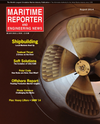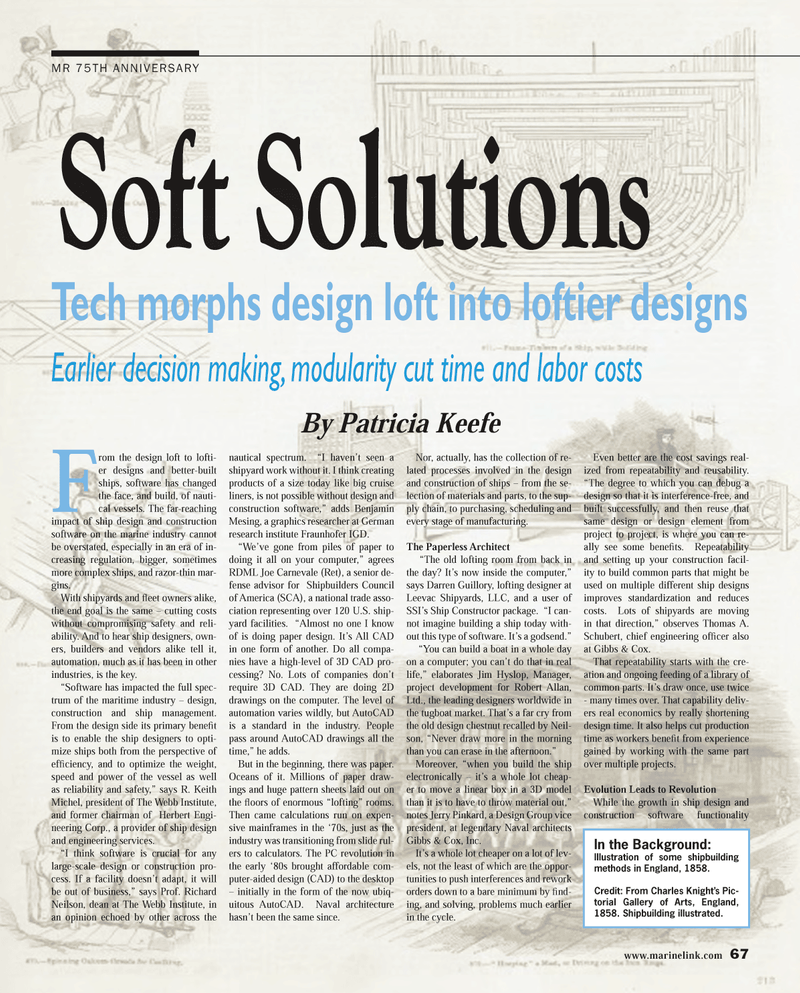
Page 67: of Maritime Reporter Magazine (August 2014)
Shipyard Edition
Read this page in Pdf, Flash or Html5 edition of August 2014 Maritime Reporter Magazine
From the design loft to lofti-er designs and better-built ships, software has changed the face, and build, of nauti-cal vessels. The far-reaching impact of ship design and construction software on the marine industry cannot be overstated, especially in an era of in-creasing regulation, bigger, sometimes more complex ships, and razor-thin mar- gins. With shipyards and ß eet owners alike, the end goal is the same ? cutting costs without compromising safety and reli-ability. And to hear ship designers, own- ers, builders and vendors alike tell it, automation, much as it has been in other industries, is the key. ?Software has impacted the full spec-trum of the maritime industry ? design, construction and ship management. From the design side its primary beneÞ t is to enable the ship designers to opti-mize ships both from the perspective of efÞ ciency, and to optimize the weight, speed and power of the vessel as well as reliability and safety,? says R. Keith Michel, president of The Webb Institute, and former chairman of Herbert Engi-neering Corp., a provider of ship design and engineering services.?I think software is crucial for any large-scale design or construction pro- cess. If a facility doesn?t adapt, it will be out of business,? says Prof. Richard Neilson, dean at The Webb Institute, in an opinion echoed by other across the nautical spectrum. ?I haven?t seen a shipyard work without it. I think creating products of a size today like big cruise liners, is not possible without design and construction software,? adds Benjamin Mesing, a graphics researcher at German research institute Fraunhofer IGD.?We?ve gone from piles of paper to doing it all on your computer,? agrees RDML Joe Carnevale (Ret), a senior de- fense advisor for Shipbuilders Council of America (SCA), a national trade asso- ciation representing over 120 U.S. ship-yard facilities. ?Almost no one I know of is doing paper design. It?s All CAD in one form of another. Do all compa- nies have a high-level of 3D CAD pro-cessing? No. Lots of companies don?t require 3D CAD. They are doing 2D drawings on the computer. The level of automation varies wildly, but AutoCAD is a standard in the industry. People pass around AutoCAD drawings all the time,? he adds.But in the beginning, there was paper. Oceans of it. Millions of paper draw-ings and huge pattern sheets laid out on the ß oors of enormous ?lofting? rooms. Then came calculations run on expen-sive mainframes in the ?70s, just as the industry was transitioning from slide rul-ers to calculators. The PC revolution in the early ?80s brought affordable com- puter-aided design (CAD) to the desktop ? initially in the form of the now ubiq-uitous AutoCAD. Naval architecture hasn?t been the same since. Nor, actually, has the collection of re- lated processes involved in the design and construction of ships ? from the se-lection of materials and parts, to the sup-ply chain, to purchasing, scheduling and every stage of manufacturing. The Paperless Architect ?The old lofting room from back in the day? It?s now inside the computer,? says Darren Guillory, lofting designer at Leevac Shipyards, LLC, and a user of SSI?s Ship Constructor package. ?I can- not imagine building a ship today with-out this type of software. It?s a godsend.? ?You can build a boat in a whole day on a computer; you can?t do that in real life,? elaborates Jim Hyslop, Manager, project development for Robert Allan, Ltd., the leading designers worldwide in the tugboat market. That?s a far cry from the old design chestnut recalled by Neil-son, ?Never draw more in the morning than you can erase in the afternoon.? Moreover, ?when you build the ship electronically ? it?s a whole lot cheap- er to move a linear box in a 3D model than it is to have to throw material out,? notes Jerry Pinkard, a Design Group vice president, at legendary Naval architects Gibbs & Cox, Inc.It?s a whole lot cheaper on a lot of lev- els, not the least of which are the oppor- tunities to push interferences and rework orders down to a bare minimum by Þ nd-ing, and solving, problems much earlier in the cycle.Even better are the cost savings real-ized from repeatability and reusability. ?The degree to which you can debug a design so that it is interference-free, and built successfully, and then reuse that same design or design element from project to project, is where you can re-ally see some beneÞ ts. Repeatability and setting up your construction facil-ity to build common parts that might be used on multiple different ship designs improves standardization and reduces costs. Lots of shipyards are moving in that direction,? observes Thomas A. Schubert, chief engineering ofÞ cer also at Gibbs & Cox.That repeatability starts with the cre-ation and ongoing feeding of a library of common parts. It?s draw once, use twice - many times over. That capability deliv- ers real economics by really shortening design time. It also helps cut production time as workers beneÞ t from experience gained by working with the same part over multiple projects. Evolution Leads to Revolution While the growth in ship design and construction software functionality Tech morphs design loft into loftier designs Earlier decision making, modularity cut time and labor costs By Patricia KeefeSoft Solutions Soft Solutions MR 75TH ANNIVERSARY In the Background: Illustration of some shipbuilding methods in England, 1858.Credit: From Charles Knight?s Pic- torial Gallery of Arts, England, 1858. Shipbuilding illustrated.www.marinelink.com 67MR #8 (64-73).indd 67MR #8 (64-73).indd 678/7/2014 9:44:35 AM8/7/2014 9:44:35 AM

 66
66

 68
68
